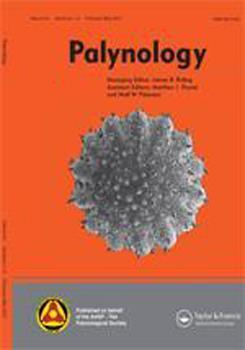Pollen in the surface sediment collected in a transect from sea to land in the Coringa mangrove wetland was analysed to determine the spatial and quantitative composition of the pollen record for palaeoecological interpretation. Autochthonous pollen preservation of the existing mangrove species was predominant in the sediments and serves as a potential indicator of coastal wetlands. The low quantity of allochthonous and parautochthonous pollen in the sediment reflects the regional plant community. Statistical analysis of the palynological data shows a high association between pollen from Avicennia marina and Clerodendrum inerme and their vegetation. Aegiceras corniculatum, Sonneratia, Ceriops decandra, Xylocarpus mekongenesis, Cocos nucifera, Azadirachta indica, Syzygium, Chenopodiaceae, Poaceae and Cyperaceae show overrepresentation. Ordination techniques for individual species using fidelity and dispersibility indices and regression analyses suggest four different floristic groups, of (i) high dispersibility-moderate fidelity taxa; (ii) high dispersibility-low fidelity taxa; (iii) moderate dispersibility-low fidelity taxa; and (iv) low dispersibility-high fidelity taxa. Species with high fidelity and moderate-low dispersibility indices could be used to identify the vegetation types in sedimentary sequences. The presence of discriminatory taxa (Avicennia marina, Sonneratia sp.), even in small quantities, helps in accurate identification of the local vegetation. Results indicate that while mangrove pollen is transported over short distances, non-mangrove pollen and spores are transported from longer distances. Thus, the status of mangrove and non-mangrove pollen in the sediments provides a clue to the (palaeo)coastal ecology and the (palaeo)climatic conditions.
How to translate text using browser tools
8 July 2019
Pollen-Vegetation Relationship in Surface Sediments, Coringa Mangrove Ecosystem, India: Palaeoecological Applications
Jyoti Srivastava,
Anjum Farooqui,
Priyanka Seth
ACCESS THE FULL ARTICLE
It is not available for individual sale.
This article is only available to subscribers.
It is not available for individual sale.
It is not available for individual sale.

Palynology
Vol. 43 • No. 3
July 2019
Vol. 43 • No. 3
July 2019
fidelity
Mangrove forests
palynologydispersibility
pollen-vegetation relationship




